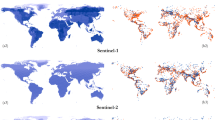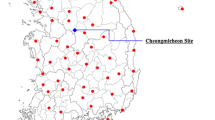Conclusion
Recent advances in remote sensing and space technology provides surface, meteorological and atmospheric information up to few hours and daily updates of any region that can be used effectively to detect, monitor, and assess flood hazard. Free and commercially available near real time remotely sensed data from various moderate to high resolution satellite sensors can be used to produce and distribute maps and data related to flood affected regions that can aid rescue and flood hazard management teams to minimize loss of life and damage. Satellite data on rainfall over a region can provide early information about potential flooding zones and flood control measures such as controlled release of reservoir water, evacuation of people living in flood prone regions can minimize loss of life and property. Multi sensor data to control flood hazard have been proved to be very useful in other parts of the world and have great potential in India. The multi sensor approach can prove to be very valuable during and soon after the floods in the monitoring of floods and assessment of damages.
Similar content being viewed by others
References
Ahmad, Q.K. and Ahmed, A.U. (2003). Regional cooperation in flood management in the Ganges- Brahmaputra-Meghna region: Bangladesh perspective.Nat. Hazards,28(1): 181–198.
Chandran, R.V., Ramakrishnan, D., Chowdary, V.M.et al. (2006). Flood mapping and analysis using air-borne synthetic aperture radar: A case study of July 2004 flood in Baghmati river basin, Bihar,Curr. Sci.,90(2): 249–256.
Chowdhury, M.D. Rashed (2004). Hydro-meteorological variability in the greater Ganges-Brahmaputra-Meghna basins.International Journal of Climatology,24 (12):
DFO (2006). Dartmouth Flood Observatory, http:// www.dartmouth.edu/-floods/
Dhar, ON. and Nandargi, S. (2003). Hydrometeorological aspects of floods in India.Nat. Hazards,28(1): 1–33.
EO (2006). Earth Observatory, NASA. http:// earthobservatory.nasa.gov
Gadgil, S., Vinayachandran, P.N., Francis, RA. and Gadgil, S. (2004). Extremes of Indian Summer Monsoon Rainfall.Geophys. Res. Letters,31, L12213, doi:10.1029/2004GL019733.
GLOVIS (2006). USGS Global Visualization Viewer.http://glovis.usgs.gov/.
Griffith, C.G., Woodley, W.L., Gruber, P.G, Martin, D.W., Stout, J. and Sikdar, D.N. (1978). Rain estimation from geosynchronous satellite data - visible and infrared studies.Mon. Wea. Rev.,106: 1153–1171.
Gupta, P.K. and Singh, A.P. (2005). Disaster management for Nandira watershed district Angul (Orissa) India, using temporal Remote Sensing data and GIS.Environ. Monit. Assess,104(1-3): 425–436.
Gupta, S., Javed, A. and Datt, D. (2003). Economics of flood protection in India.Nat. Hazards,28(1): 199–210.
Jain, S.K., Singh, R.D., Jain, M.K.et al. (2005). Delineation of flood-prone areas using remote sensing techniques.Water Resour. Manag.,19(4): 333–347.
Joyce, R.J. and Arkin, P.A. (1997). Improved estimates of tropical and subtropical precipitation using the GOES Precipitation Index.J. Atmos. Ocean Tech., 14:997–1011.
Kale, V.S. (2003). Geomorphic effects of monsoon floods on Indian rivers.Nat. Hazards,28(1): 65–84.
Kale, V.S. and Hire, P.S. (2004). Effectiveness of monsoon floods on the Tapi River, India: role of channel geometry and hydrologie regime.Geomorphology,57(3-4): 275–291.
Kumar, R. and Chatterjee, C. (2005). Regional flood frequency analysis using L-moments for North Brahmaputra region of India.J. Hydrol. Engg.,10(1): 1–7.
Kumar, R., Singh, R.D. and Sharma, K.D. (2005). Water resources of India,Curr. Sci.,89(5): 794–811.
Latrubesse, E.M., Stevaux, J.C. and Sinha, R. (2005). Tropical rivers.Geomorphology,70(3-4): 187–206.
May, W. (2004). Variability and extremes of daily rainfall during the Indian summer monsoon in the period 1901-1989.Global and Planetary Change,44(1-4): 83–105.
MODIS (2006). MODIS Rapid Response System, http:/ /rapidfire.sci.gsfc.nasa.gov/.
Mohapatra, M. and Mohanty, U.C. (2005). Some characteristics of very heavy rainfall over Orissa during summer monsoon season.J. Earth Syst. Sci.,114(1): 17–36.
Mohapatra, P.K. and Singh, R.D. (2003). Flood management in India.Nat. Hazards,28(1): 131–143.
Nandargi, S. and Dhar, O.N. (2003). High frequency floods and their magnitudes in the Indian rivers.J. Geol. Soc. India,61(1): 90–96.
Prasad, A.K. and Singh, R.P. (2005). Extreme Rainfall Event of July 25-27, 2005 over Mumbai, West Coast, India.J. Indian Soc. Remote Sensing,33(3): 365–370.
Prasad, A.K. and Singh, R.P. (2006). Features of Hurricane Katrina Using Multi Sensor Data.International J. of Remote Sensing (in press).
Sanyal, J. and Lu, X.X. (2005). Remote sensing and GIS-based flood vulnerability assessment of human settlements: a case study of Gangetic West Bengal, India.Hydrol. Process,19(18): 3699–3716.
Sarma, J.N. (2005). Fluvial process and morphology of the Brahmaputra River in Assam, India.Geomorphology,70(3-4): 226–256.
Singh, C.V. (2001). Probabilities and distribution of monsoon rainfall in normal, flood and drought years over India.Meteorol. Atmos. Phys.,78(3-4): 205–214.
Singh, C.V. (2004). Empirical Orthogonal Function (EOF) analysis of monsoon rainfall and satellite-observed outgoing long-wave radiation for Indian monsoon: a comparative study.Meteorol. Atmos. Phys.,85(4): 227–234.
Spence, R. (2004). Risk and regulation: can improved government action reduce the impacts of natural disasters?.Build Res. Inf.,32(5): 391–402.
SVS (2006). Scientific Visualization Studio, NASA. http://svs.gsfc.nasa.gov/.
Vincente, G.A. (1996). Algorithm for rainfall rate estimation using a combination of GOES-8 11 and 3.9 measurements.Proc. Eighth Conf. on Satellite Meteorology and Oceanography, Atlanta, GA, Amer. Meter. Soc, pp.274–278.
Wu, R., Weinmann, J.A. and Chin, R.T. (1985). Determination of rainfall rates from GOES satellite images by a pattern recognition technique.J. Atmos. Oceanic. Technol., 2: 314–330.
Author information
Authors and Affiliations
Corresponding author
About this article
Cite this article
Prasad, A.K., Vinay Kumar, K., Singh, S. et al. Potentiality of multi-sensor satellite data in mapping flood hazard. J Indian Soc Remote Sens 34, 219–231 (2006). https://doi.org/10.1007/BF02990651
Received:
Revised:
Issue Date:
DOI: https://doi.org/10.1007/BF02990651




